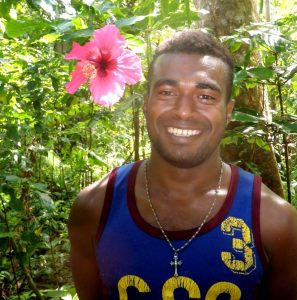Rare Ruby Unearthed
A New Species Of Hibiscus From The Garden Island Of Fiji
Three weeks after Tropical Cyclone Winston – the strongest storm ever recorded to make landfall in the Southern Hemisphere – I was back in my beloved Fiji. On the Garden Island of Taveuni I had originally planned to search for the rare and highly endangered Hibiscus storckii (see July issue of FijiTime) but with mountain peak vegetation defoliated by Winston there no hope of locating the elusive cloud forest Storck’s Hibiscus and quite rightly the Fiji Government and everyone’s focus was on emergency assistance to devastated communities, including on southern Taveuni which bore the brunt of Winston.
On the Saturday morning (12th March) I planned to visit Lavena. Having just missed the bus at Wairiki, and not wanting to wait several hours for the next one, I ran flat out eventually catching up with the bus after a kilometre of stop, starts and gasps– and providing amusement to locals watching on. It was hot, steamy, sweaty, dusty slow ride on a packed market day bus. A Fijian girl was talked into giving up her open window seat and allowing me to keep an eye out for any roadside senitoa. Senitoa is the Fijian name for Hibiscus – literally translated it would be the flower of the chicken or fowl, and certainly the drooping scarlet Hibiscus flower, often worn behind the ear in the Pacific, resembles a rooster’s comb.
As the bus meandered along the east coast of Taveuni, I was amazed to observe the hillsides of red-flowering vure (Geissois) trees in the vicinity of the aptly named around aptly name Vurevure Bay. Trees totally defoliated by Winston just two weeks earlier were now festooned in bright red, nectar-rich blossoms and alive with fruit bats feasting and flapping around in the glare of the midday sun. What a wonderful adaptation for effective cross-pollination – vure trees provided an abundant food resource for pollinating fruit bats, honeyeaters and kula lorikeets when no other food sources were to be found. I also thought Fiji bee-keepers might take advantage of this trait and plant a few vure trees in the vicinity of their hives.
Arriving into Lavena it was shocking to see the structural damage to this seaside village. Lavena had taken the full force of the Category 5 Winston with many buildings damaged or totally destroyed and draped into makeshift tarpaulins provided by Australian Aid. On a bright note it was heartening to hear and witness the resilient attitude of the locals to rebuild, some in the wake of having just lost everything before the bus quickly turned around and, with no shops open, the local generosity in sharing a bottle of Fiji Water. On the return bus journey I caught a fleeting glimpse of a dark-eyed, pink-flowered Hibiscus which resembled Hibiscus storckii. Could this be the elusive ‘ storckii’?
It was late in the afternoon when Tutu’s Father Michael McVerry drove me back to have a closer look at the pink Hibiscus. There were two plants growing in the Villa Maria Settlement, which on closer inspection I determined to be the Hibiscus known internationally as ‘Ruby Rose’. We met with Mr Suliano Manabua, who was well-known to Father Michael as both Suli and his parents had previously attended Tutu’s married couples programs. It was then that Suli dropped a Hibiscus bombshell. He said that his father, Sepo, had collected the cuttings of ‘Ruby Rose’ from a remote location in the Waibula River catchment in 2004 and that is was growing wild. The wild origins of ‘Ruby Rose’ – one of the most spectacularly beautiful miniature flowered Hibiscus – were beginning to emerge. Following our discussions with Suli, Father Michael promised to arrange for Tutu’s young farmers from Villa Maria to relocate the wild Hibiscus and I determined to visit the isolated site to confirm its wild origin.
It was the second week of June before I could get back to Taveuni. On the 8th June Father Michael arranged for Suli and his son Sepo to be my guides on the quest to locate ‘Ruby Rose’ in the wild. I had been told that the Reality TV program ‘Survivor’ had cut a new road that led to near where the ‘Ruby Rose’ grew, and that only a 30 minute hike was needed, but alas this turned out not to be the case. Due to land dispute and damage to the walking track by Winston the walk in turned out to a difficult hike up and down several precipitous valleys. During the walk I was sustained and revitalized by bush foods and medicines including young tubers of layalaya (a wild ginger), and the fresh leaves of warusi (a wild sarsaparilla sometimes known as bush viagra and an excellent blood tonic), an aromatic Fijian cinnamon and sekau – a primitive tree with edible leaves and fruits.
The wonderfully diverse forest included the noted Fijian timber trees kuasi (Fijian plum pine) and yasiyasi, the lovely perfumed epiphytic bua ni viti, the edible ivi or Tahitian chestnut, with rich understorey of endemic palms and ferns. The walk through the forest was punctuated by the calls of songbirds including the orange dove (bune) and the Fiji bush warbler and occasional screeches of the red shining parrots and kula. We traversed an elevated pathway or tua which fell away steeply on both sides and which Suliano informed was used to trap hapless strangers during the Cannibal era, and I was glad to be alive today. After several hours we reached the impressive broad valley of the Waibula River – the largest river on Taveuni. We were greeted by three young farmers who had been maintaining substantial yaqona or kava plantings. We rested before making the final half-hour scamper over the boulder Waibula River to the site where the Hibiscus was known to occur. Two of the Hibiscus plants had died or been destroyed by Winston but to my delight one plant with a single unmistakably beautiful ‘Ruby Rose’ Hibiscus flower had survived.
 The yaqona farmers informed that ‘Ruby Rose’ Hibiscus was more plentiful in the upper reaches, but that it entailed an arduous and treacherous 5 or 6 hour walk.
The yaqona farmers informed that ‘Ruby Rose’ Hibiscus was more plentiful in the upper reaches, but that it entailed an arduous and treacherous 5 or 6 hour walk.
We collected cuttings and botanical specimens of the new Hibiscus before returning in the late afternoon to Villa Maria – fatigue and aches kept at bay by a thoroughly exhilarating day of discovery.
Later I learned of a possible reason for the wild Fijian origins of ‘Ruby Rose; being hidden until now. Accordingly to Pacific linguistic expert Dr Paul Geraghty and Qeleni village informants Di Lutu, an ancestor goddess of Qeleni, ‘haunts’ a pool not far from the village and wears a ‘Ruby Rose’ hibiscus flower behind her ear and perhaps this has deterred its local planting as an ornamental.
I am now working on formally naming the undescribed species in honour of Father Michael in recognition of his assistance in finding the new species and for his contributions to Taveuni and the work of Marist Tutu Rural Training College to train young farmers and married couples on Taveuni (including my guides from Villa Maria Settlement Suliano and his son Sepo, and deceased grandfather Sepo who had brought ‘Ruby Rose’ from the wild).
My research has determined that Taveuni now has two native species of Hibiscus – and both arguably with the most attractive flowers of any tropical Hibiscus species – and two more reasons for visiting and exploring the appropriately named Garden Island of Fiji.



